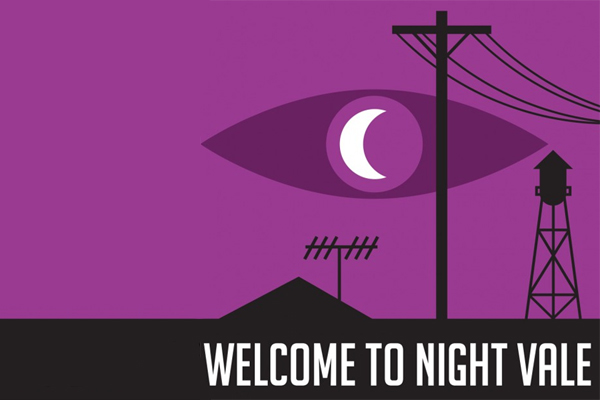Welcome to Night Vale is a bi-monthly podcast created by Joseph Fink and Jeffrey Cranor that has been running since 2012. It is very cleverly written, and I recommend it as a humorous take on the particular brand of paranormal Americana exhibited in shows like Twin Peaks, Gravity Falls, Alan Wake, and the works of Stephen King. It also has an anthology radio quality reminiscent of Twilight Zone, and I decided this program would make a really good setting for an adventure in this type of world.
I ran this game in FATE, because that system supports a lot of non-combat action, and I knew that this game was going to be have more themes of mystery and horror than combat. I had also considered the Gumshoe system, but FATE won out with its versatility and narrative strengths.
Setting the Mood
Night Vale games have required more prep time than others, because cleverly scripted jokes and creepy imagery is the main goal. For setting the mood, I placed purple and blue tissue paper over the lights to created a color-tinted ambiance.
To further put my players on edge, I got a Jenga tower and added a variation of the game mechanic from DREAD, in which you pull blocks from the tower whenever you take an action. In my version, you only pulled a block when something strange happened, to represent the strain on your sanity and raising of the stakes. When the tower falls, it triggers a major encounter. Something evil finds you, or something terrible happens to an ally. This, combined with a playlist of eerie and unnerving theme music brings out the weird Night Vale atmosphere that we love.
I didn't pressure myself too much to create all-original jokes, nor did I worry about sticking strictly to the lore of the setting. Too much adherence to the canon of a series kills the fun of building and exploring a world with your players. For the first adventure, I set everything inside a shopping mall so I didn't have to worry about the rest of the town right away. A mall is like a self-contained community so there would be plenty of places of interest within.
To speed this process, I built a series of tables specifically for the setting. You could create your own aspect for a character from scratch, or you could roll off a table to get some basic inspiration for your looks, occupation, a location you are most familiar with, or special talent. This could be used to replicate the settings signature combination of the mundane and strange, such as:
You can find everything you need to know about this setting in text form at the Night Vale Wiki.
Happy ventures!
 |
| Everybody loves a Strexpet™! |
Character Creation
- A museum curator with a non-linear perception of time
- A dog walker with scars all over their body
- A homeless man with the ability to break the fourth wall
- A cubicle worker who speaks with a particular type of animal
Once their first few aspects were chosen, the player could then choose skills and I would help them pick out a stunt or two from the list that can be found here. Then we were ready to enter this friendly desert town where the sun is hot, the moon is beautiful, and mysterious lights pass overhead while everyone pretends to sleep. Stay tuned to find out what happened!
You can find everything you need to know about this setting in text form at the Night Vale Wiki.
Happy ventures!









